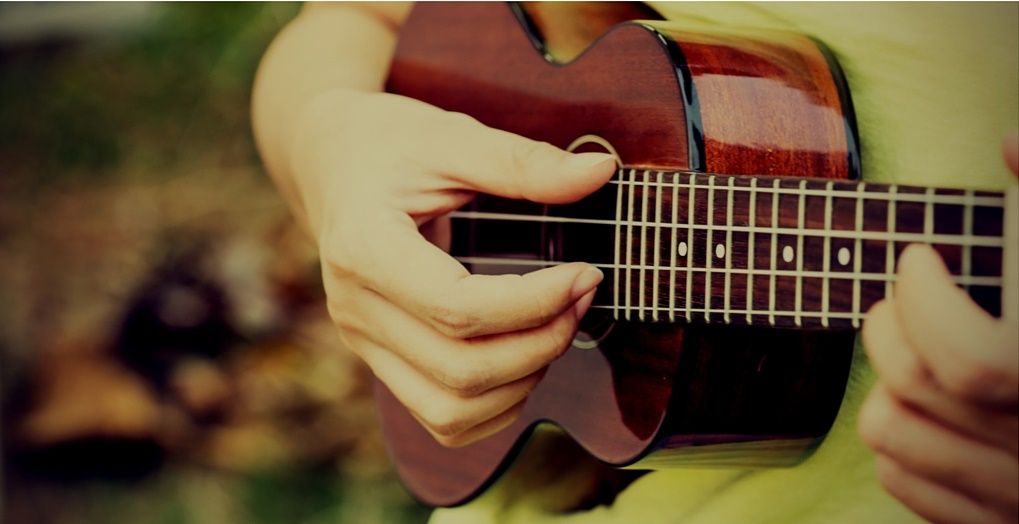Even if you are a professional ukulele player, having an out of tune instrument is going to make you sound horrible. We’ll teach you how to tune your ukulele and keep it in tune. Different ukes will hold a tune better than others, it’s best to check every time before you play.
How is my ukulele tuned?
The most common tuning for a ukulele is G-C-E-A. This tuning is pretty typical for soprano, concert, and tenor ukuleles. If you are used to playing a guitar, the four stringed concept with a uke is much less than a 6-12 string guitar. From the image below you’ll see the top string, or fourth string, is G, then C, E, and ending with A on the first string.
[tcb-script id=”mNCC” language=”javascript”]medianet_width = “600”;medianet_height = “250”;medianet_crid = “712534424”;medianet_versionId = “3111299”;[/tcb-script][tcb-script src=”//contextual.media.net/nmedianet.js?cid=8CU7GM763″][/tcb-script]
The standard ukulele tuning of G-C-E-A can be tuned one of two ways, reentrant or linear. Reentrant tuning strings are not ordered from the lowest to highest pitch. This can be confusing if you’re used to playing a guitar.
Linear tuning is when the G is tuned down an octave, creating a broader tonal range. If you want to sound and play more like a guitar, opt for linear tuning.
What are other ukulele tuning options?
Baritone ukuleles, and sometimes tenor ukuleles, are tuned to D-G-B-E, or standard ukulele tuning. An easy tip for tuning a baritone uke, is to remember that the four strings are the same as the four highest-pitched strings on a guitar. This means you can also use guitar tuners to tune your ukulele.
Slack-key tuning of G-C-E-G is based on the original Hawaiian style of playing. When all the strings are open you get a C major chord. The G can be tuned either with reentrant or linear tuning. This means that the G can be tuned to above middle C or below.
English tuning, A-D-F#-B, has sweeter tones, because the strings are tuned up one whole step. You’ll find this a lot with soprano ukuleles.
And lastly, we have Canadian tuning (low) A-D-F#-B. Canadian tuning is very similar to English tuning, except each note is tuned down a half step. This is popular with your concert and tenor ukes.
What are the different ways to tune my ukulele?
To adjust the pitch of the ukulele strings, loosen or tighten the tuners or tuning pegs. Tighening the strings will raise the pitch, and loosening the strings will lower the pitch. The direction you twist the tuners can vary by instrument.
Be careful not to make them too tight. This can damage your instrument and break the strings.
You can tune your uke by yourself, with a gadget, or with others, if you’re getting ready to do a gig. It depends on what you have going on around you and what/who you’re with.
How do I tune my uke by ear?
If you’re all by your lonesome and have no tools, gadgets, do-dads, or friends with instruments to create relative tuning, you can tune your uke by yourself. Yay for being independent! The relative tuning method, or tuning by ear, isn’t as accurate as others, but is still doable.
- Play the C string. By ear, if it sounds sharp or flat adjust the tuners.
- Now play the fourth fret of the C string, this is E. E should sound the same as the open E string. Adjust the open string if it is not the same as the fretted note.
- Repeat the second step with the third fret of the E string, or a G note. Make sure it matches with the open G string and adjust.
- Lastly, play the second fret on the G string, or an A note. This should sound the same as the open A string. Ensure this is in tune with the fretted note.
It may take some practice to tune your ear to the different tones, but it’s an easy, uncomplicated way to tune your ukulele on the go and without any assistance.
[tcb-script async=”” src=”//pagead2.googlesyndication.com/pagead/js/adsbygoogle.js”][/tcb-script][tcb-script][/tcb-script]
How do I tune my uke with a piano?

Having a reference instrument, is an easy way to tune your ukulele. With a piano handy, you can follow these easy steps.
- Play a G on the piano, then play the G string. Adjust the pitch of the strings as needed.
- You can choose to use the piano as a reference for the rest of your strings, or use the relative tuning (as described above) to tune the rest of your ukulele.
- If you choose to tune the rest of your uke strings with the piano, continue by playing C, E, and A on first the piano, then the ukulele.
How do I tune my uke with an electric tuner?
There are two types of electric tuners. You can opt for a ukulele tuner that has a built in microphone to gauge the sound of your ukulele. Another option is to buy a tuner that attaches to your instrument and detects the strings’ vibrations to identify the tone.
Electric tuners are one of the easiest ways to tune a ukulele. They aren’t always easily accessible or may not be ideal for the uke player on a budget.
Personally, I use the Intellitouch PT10 tuner. It works for both guitars and ukuleles, which is great for the versatile musician. Another benefit, is this gadget works well even in loud or crowded rooms. I find it very accurate and like being able to just take a glance at the headstock while I’m playing to see whether I’m in tune.

Image courtesy of Amazon
[tcb-script async=”” src=”//pagead2.googlesyndication.com/pagead/js/adsbygoogle.js”][/tcb-script][tcb-script][/tcb-script]
Use Your Phone!
If none of the above options are your favorite, try the easiest way to tune your uke. There are several apps that you can download on your tablet or mobile phone to help you tune on the go.
For Apple products try the Ukulele Tuner. For Android and other devices give Easy Ukulele a go! These apps will make your life simpler!
After reading through this article, you now have an understanding of how to tune your ukulele three different ways: by ear, with a piano, or with an electric tuner. Now you can be prepped and ready to go whether it’s before a gig in front of all your fans, or before you start a jam sesh on your couch at home.
For more information, take a gander at these Coustii recommended sites:







